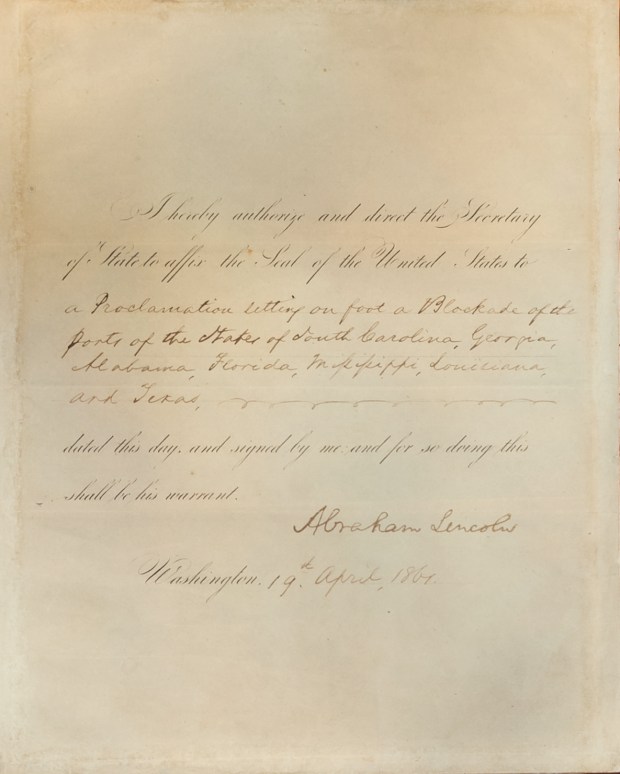SPRINGFIELD — Following the Confederacy’s 1861 attack on Fort Sumter, often viewed as the event that sparked the Civil War, then-President Abraham Lincoln had to decide how to retaliate against the Southern states.
The Anaconda Plan would be the result, a critical strategy the Union employed to cut off the supply chains to the South that would remain in place until the Confederacy was defeated in 1865. The plan became Lincoln’s first direct military action against slave states trying to secede, and it’s codified in a document formally called the “Order to Affix Seal of the United States to a Proclamation of a Blockade.”
On Tuesday, Gov. J.B. Pritzker and his wife, M.K., donated that historic document to the Abraham Lincoln Presidential Library and Museum in Springfield. The couple acquired it at auction for $471,000. It’s now one of about 13 million documents and artifacts amassed at the Springfield library and museum.
“This was an act of leadership that required careful consideration but also courage and immediate action to take every action possible to keep the nation intact,” the governor said to a small audience during a ceremony at the library, flanked by his wife, moments before the framed document was unveiled. “To me, this document and the museum as a whole serves as a reminder of how far we’ve come as a nation. Despite our current divisions and challenges, more than 150 years after a terrible Civil War, our nation perseveres.”
Ian Hunt, the acquisitions director for the library and museum, explained the historical significance of the document, discussing the division within Lincoln’s cabinet over how to respond to the Fort Sumter attack and Confederate President Jefferson Davis’ plans to authorize private citizens in the South to capture U.S. shipments, actions that would amount to piracy.
The Anaconda Plan was championed by Winfield Scott, the general and chief of the U.S. Army, who believed it would prevent the Southern states from selling agricultural commodities like cotton and tobacco to Europe, while at the same time denying the South access to arms, munitions and heavy machinery.
But U.S. Secretary of the Navy Gideon Welles felt the Navy was too small and ill-equipped to properly patrol the roughly 2,500 miles of the Atlantic Ocean and Gulf of Mexico shoreline. Welles advised that a port could be closed and law enforcement could search and seize vessels with contraband if necessary, which would effectively impose an embargo, Hunt explained.
U.S. Attorney General Edward Bates warned that a blockade was “an act of war” that would by default recognize the Confederacy’s independence.
The cabinet ended up being split down the middle on the issue, and Lincoln chose to order the blockade.
“This document, asking the secretary of state to affix the seal of the United States to his proclamation, was the final step in making the president’s proclamation official,” Hunt said. “While the blockade may not have the dramatic moments that other famous battles such as Gettysburg or Vicksburg are remembered for, it was no less important. It denied the Southern economy much needed revenue from the sale of agricultural exports while simultaneously skyrocketing prices in the South on the limited materials that did make it through.”
Calling the document from April 19, 1861, a “magic piece of paper,” Christina Shutt, the library and museum’s executive director, said it represents “a terrifying decision point” for Lincoln.
“Seven states have already announced they want to tear America apart, rather than risk any chance of freedom for 4 million enslaved people,” Shutt explained. “They opened fire on U.S. troops and seized federal property. They stole weapons and (began) amassing an army. Now the president must decide whether to act boldly to win a war the Confederacy has started or dither and hope that somehow the crisis fails. It was a moment like no other in American history.”
The document will be available for viewing in the library and museum’s Treasures Gallery beginning Wednesday and will remain on display until February, when it will be transferred to the library and museum’s vault.





